

The most charming and therapeutic walk for me through the city of Volos is the path from the park of Saint Constantine until Anavros. I have walked there many times before, sometimes with friends and sometimes alone. The walk through parks, Exoraistiki, the few old houses, the train lines, the church of St. Constantine, hotel Xenia, the Aquarium, the hospital, the Archaeological Museum and the sea was one of my companies during my student years. It was the way of relaxation, meditation, historical and urban fantasy.
What is the real city I live in? How would I feel if I walked there 50, 100 or 150 years ago?
How many humans lived and grew up there, and what natural phenomena changed the city? How much do my fantasies agree with the historical truth through the traces and stasis of this path?
Supervisor: Papadimitriou Maria
Reference Number: 350
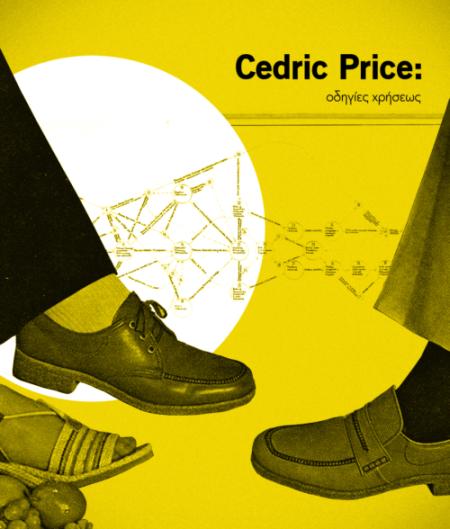

The dissertation examines the architecture of Cedric Price as it evolved during the 60s and 70s in Britain. Based on three three unimplemented projects this thesis will explore the design methods he developed, to propose a shift from an object-oriented architecture to an anti-architecture of experience and free participation.
Cedric Price was among the first architects who applied theories from the fields of cybernetics and systems analysis in architecture to produce new forms of spatial organisation. He used diagrams, computer programs, networks and artificial intelligence as tools for the production of exchange environments with the characteristics of open systems.
The technological approach taken by Price in his projects, reflects the emergence of the Information era, and is due to the unstable social nature of postwar Britain. The efford of incorporating randomness of operations in a program to encourage unpredictable behaviors and activities led to the controversial idea of "calculated uncertainty ': architecture provides a framework within which different decisions and wishes may be realised.
Supervisor: Tzirtzilakis Yorgos
Reference Number: 353


The modern city dweller comes across the deterministic modern architecture that treats him as a passive user, unable to transform the space and its meaning. The big city urban environment contributes to the creation of ghettos, where the underground culture is born. In this frame, the passive/creative user dipole is constituted, on which the graffiti movement will be studied.
The term “creative user” describes the graffiti writer as a creative reader of the city and as an urban activist who manipulates and transforms public space through a series of semiotic mechanisms.
The term “creative loser” is used to describe the passage from the postmodern and angry graffiti of the 70’s to the constitution of a deconstructed metalanguage, which as a visual product, loses its dynamic in public, thus developing close ties with marketing and the media.
Studying the historical evolution of graffiti is essential to clarify the boundaries between the creative user and the urban loser. The objective of this research is to examine whether graffiti is a creative gesture that counteracts the contemporary dystopia.
Supervisor: Tzirtzilakis Yorgos
Reference Number: 307
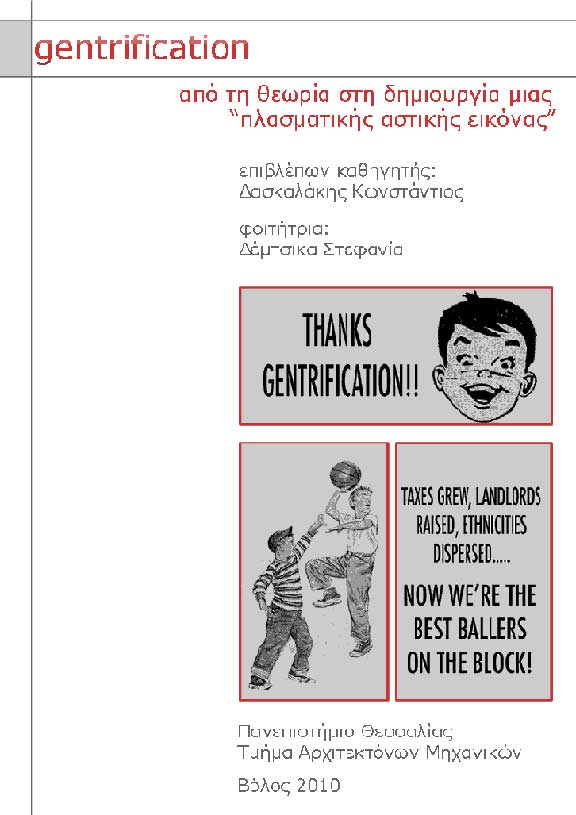

This paper, which is methodologically constructed by three different parts, studies, analyses and tries to apprehend the depreciation procedures of central residential areas and their reevaluation through either small or large scale renovation projects, related to the effect described as gentrification.
In the first part of this paper, we try to approach gentrification and find out the causes, through the analysis of the term and its different theoretical approaches. Thereafter, we quote the basic variables and factors which affect the procedure focusing in the downgrade of urban centers, a hub to the implementation of the renovation projects through a strict institutional line. Using gentrification as a theoretical implement, we investigate the outcome of these projects in social and urban fabric, which are boiled down to a factitious urban figure.
In the second part, areas such as Tompkin's Square Park in New York, Bologna, Bilbao and Castro in San Fransisko are investigated preparative to inspect gentrification through its different theoretical approaches and different expressions.
In the third and last part of the paper, the investigation goes over Athens, in bigger extent than the previous examples, in order to find out whether it is appropriate the urban renewal processes in terms of gentrification. The frequent reference to the growing renewal in the local press leads to a further analysis of the Athenian centre, based on the 2001 census.
Subsequently to the approach of gentrification, we try to evaluate the phenomenon based on all above elements, in relation to the theoretical substratum, the different expressions and the quality of the generated outcome. In the same way, such conclusions concerning potential gentrification tenses are finally produced in the case of Athens.
Supervisors: Kanarelis Theoklis, Daskalakis Konstantios
Reference Number: 345
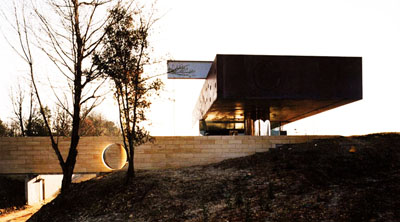

“Maison a Bordeaux” is a private house. It is situated on the outskirts of the city Bordeaux, on a hill and overlooks the entire city. It was built between 1994 and 1998 from the architect Rem Koolhaas for Jean-Francois Lemoine. This house is considered appropriate to be studied for the following reason: It wasn’t built simply for a family that desired a new home, away from the centre of the city and was looking for a more peaceful (quite) life away from it, but presupposed at the same time a pressing need for the owner himself. The owner, after a car crash, was stagnated in a wheel chair. Thus, he wanted a house that would cover his particular needs, while would create different stimuli to him and the rest of the users, since this house would be his own world, as he would be confined to it. The challenge for this construction was rather great for the architect who undertook this task, since he wanted to design a house, that would meet in full the conditions, which make easier the life of a person with physical disabilities and at the same time more enjoyable, while, simultaneously, he would evade the common design solutions, which appear this houses either ground floor either with more floors, that are accessible with ramps or with ordinary lifts. In the case of this special customer, who is confined to a wheelchair, Rem Koolhaas elaborates the meaning “prisoner of architecture”, which is open to various meanings. The accommodation of the house is on three floors, which are accessible with a lift – hydraulic platform: the first level includes the domestic segments, the second the relaxation section and the third the rooms. This building develops research topics, which have already been suggested by the architect: asymmetry, homes fit, heterogeneity of the materials. The experimental house was not designed to remain stable, but it must evolve with the needs of the owners. For the Lemoine house we could say that depending on each floor, appears a different kind of house. On the first floor we find the primitive hut, on the second floor the glass house of modernity and continuously on the third floor a huge box with punched windows, which are at a specific location. Besides the above, this house is particularly interesting in static mode and in the structural way that was finally selected. At “Maison a Bordeaux”, because of its shape, had to be given particular attention at the process by which was achieved the balance of this structure. Cecil Balmond, the engineer who undertook the house, checks the calculations and the science of engineering in home and manages to take out the challenge, according to which a house must be concentrated and simultaneously it must be suspended at three points. In general, we could say that “maison a Bordeaux” or “maison at Floirac” or “maison Lemoine” (as are the three names, which are used commonly for this) is the house of a family, where the technology and the architecture join forces to create a world, that is simple and complicated at the same time. The architect combines creatively the functionality, the design and the innovation. Already, in the additional inventory of historic data of 2002, this house was considered an architectural gem, that belongs to the end of the 20th century.
In the research that was made for this house, it is examined the house’s background (record), the architectural solution that chose the architect in order to make the house more functional and accessible to its owners, its static, its materials, the development of the landscape and the electromechanical installations which are inside. Through this study result conclusions both for the home, when it is examined on its own, but also when it is compared with other homes which present many similarities to “maison a Bordeaux”.
Supervisor: Adamakis Kostas
Reference Number: 348
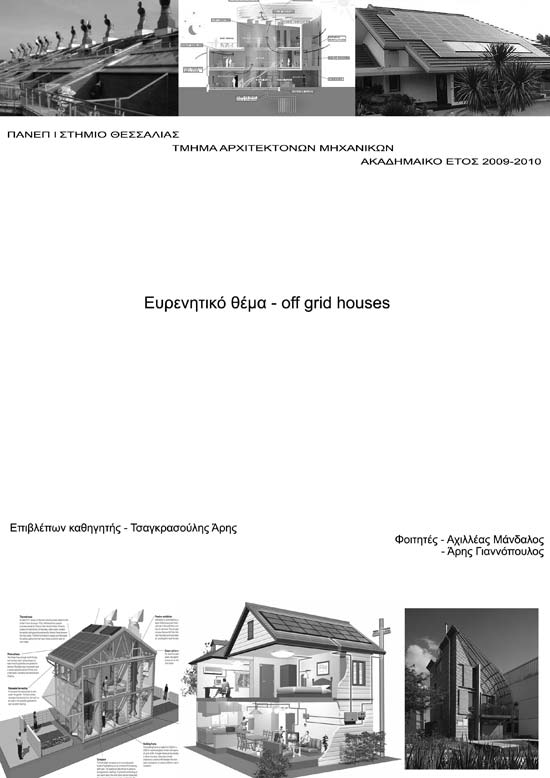

The environmental problem keeps growing on and it needs immediately an effective solution, in order to improve the quality of life and to save the planet which is now on risk. In this paper there is a general presentation of the problem that buildings, which are not consistent with the current technical standards, are facing nowadays. Also, what the Greek law provides so it could be abide by that of the EU in the issue of the construction of buildings. The renewable resources of energy and the ways that they can be used at a house level, are described as well.
The most popular standards of energy certification, the goals they are trying to achieve and the methods that they use are referred in short. In addition, successful examples of “passive” houses, the analysis of the ways that are used in order to succeed law energy consumption and the materials are used, are included in the paper. Finally, we describe the alternative ways with which an existing house can reduce the heating load and also the ways of the whole reduce of its energy requirements until the house reaches the level autonomy.
Supervisor: Tsangrassoulis Aris
Reference Number: 323
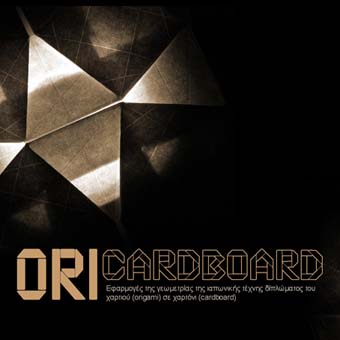

Origami, is the ancient Japanese art of paper folding. In the past few years this art have stirred the interest of a wider public like mathematicians and scientists, but fashion designers and architects as well. These people, experiment with various materials to design something, depending on their field of interest.The aim of this project is to study the origami techniques, but also to investigate how capable is cardboard as an efficient material for the application of the origami geometry to architecture and to product design. Is it possible to make folds with cardboard? Could the outcome of this folding procedure be a residence, a shelter or an armchair from cardboard?
The greatest part focuses in the study of origami application in the different ways of designing and formatting. Furthermore, there is a study of the cardboard possibilities, through his examples and applications, that practically prove the range of its cababilities. Worldwide, there are not a lot of applications, because the origami - cardboard combination is still under research. In this project, there are presented also a few of personal experiments of selective forms and drawings of origami on cardboard.
Supervisor: Vyzoviti Sophia
Reference Number: 344
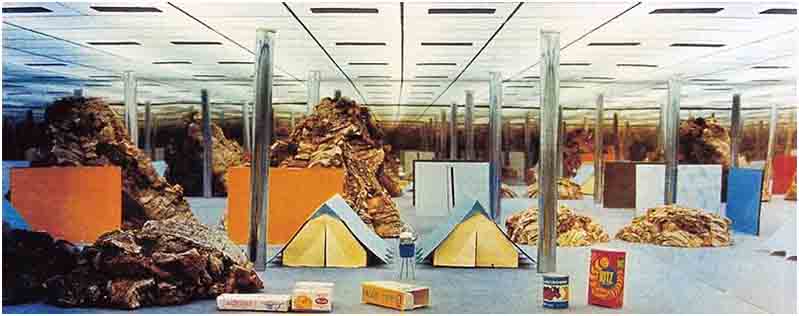

The rise of the finance and the global commercializationcreated a need to expand in larger areas with different situations that brought the creation of centre – off center, cutting off the social and cultural activities from the finance and combing them with entertainment. Through the years we came across several types of shopping areas. New types of cities centers are rising as a part of the city but also as unique independent spaces. The public and private spaces are becoming one in order to assist the corporate wealth. The Mall Athens, the first of the mall in the Greek area, and a series of others brought a new breeze in the city of Athens. The Shopping Malls not only compete the public space but in many cases they took over entirely, operating under the infrastructure works that took place in Athens for the Olympic Games of 2004.
Supervisor: Tzirtzilakis Yorgos
Reference Number: 310

